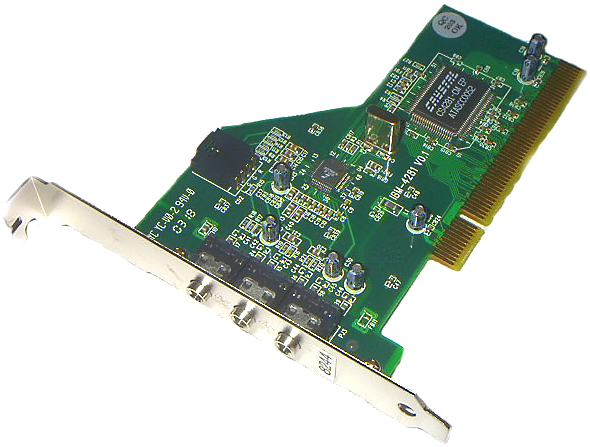AIX PCI Audio Adapter - FC8244
System Type: 8244

Unanimous on a lot of RS/6000 systems and some IntelliStation POWER machines. It succeeded the M-ACPA and judging from references in documentation most likely was available before 2002. To discourage continued use, IBM stopped selling them after 2005 but were still supported under AIX 5.3, 6.1 and 7.1. Because there were two FRUs, one RoHS and one non-RoHS, they would have been produced during a time when lead was still somewhat used in solder. There's also a third FRU mentioned in the seventeenth edition of "pSeriesAdapters, Devices, and Cable Information for Multiple Bus Systems" (October 2003) which does not state whether or not it's RoHS or non-RoHS complaint, if I had to guess without seeing one probably non-RoHS.
FRUs
10N7732: RoHS compliant.
80P2598: non-RoHS complaint.
00P4648: ???
Downloads
--> CS4281 Datasheet
--> CS4299 DAC Datasheet
--> Adapter Placement Reference for AIX
Crystal PCI Audio Chipset
The card is fairly basic and features a Crystal CS4281 PCI-bus specific audio controller chip accompanied by the partnering DAC (4299-JQZ / CX4297A). The CS4281 does support a joystick port and digital out, but IBM never implemented these features physically on the card: I don't know if IBM had the card manufactured specifically for their systems or if it was re-badged; many PCI soundcards were built upon CS4281. Here's Cirrus Logic's description of the chip from the datasheet:
Lazy Circuit Design
The DAC datasheet clearly states that the two decoupling capacitors (C31, C32) should be 220uF, but instead IBM just steam-rolled the entire board with 10uF. Therefore to get optimal performance out of the DAC, replace those capacitors with 220uF.
The CS4281 is a PCI audio controller with integrated legacy games support suitable for desktop and notebook PC designs. When combined with driver software and an AC '97 codec such as the CS4297A, this device provides a complete high quality audio solution. Legacy compatibility is achieved via PC-PCI, DDMA, and CrystalClear Legacy Support. The product includes an integrated FM synthesizer and Plug-and-Play interface. In addition, the CS4281 offers hardware volume control and power management features. WDM drivers provide support for Windows 98 and Windows NT. When used with the CS4297A, the CS4281 is fully compliant with Microsoft's PC '98 and PC '99 audio requirements. In the 100-pin MQFP package, the CS4281 is pin-compatible with the CS4614 and CS4280-CM.
As mentioned in the IBM pSeries p5 Systems documentation, it has basic audio functions and operates as early as AIX 5.1.
The Audio PCI Adapter for Workstations is a high performance workstation class audio PCI adapter that is optimized for support in the AIX professional workstation environment. It is a 3.3V 32-bit PCI Adapter that runs at 33MHz speed and complies with the Intel AC 1997 Version 2.1 specifications.
The Audio PCI Adapter for Workstations provides external jacks for headphones, speaker output, line input and microphone input - as well as an internal connector for CD or DVD Drive audio input.
AIX 5.1 with May 2002 update CD or later
AIX 5.2 with May 2002 update CD
I personally wouldn't consider CS4281 "workstation-class" in regards to audio and music production since it's just too limited--but Crystal (now Cirrus Logic) chips are fairly robust. Their SoundBlaster compatibility can be slightly off at times, however. Since AIX doesn't exactly run DOS we won't be concerned with that...
Beyond AIX
Theoretically you could solder on a connector to extract them for this specific card design, however existing CS4281 cards with joystick ports could be used instead, you would then be tasked with getting and/or programming joystick support for AIX yourself.
Because the card is based on CS4281 and contains nothing special, that means any CS4281-specific card should work on AIX and behave as "feature code 8244", conversely this also means you can use the card in any regular x86 PC and use it. This brings up a few questions because CS4281 has a lot more features than are probably utilized by AIX (now). Here are the features in question:
- Full DOS Games Compatibility via PC/PCI, DDMA, and CrystalClear Legacy Support
- MPU-401 interface, FM Synthesizer, and Game Port
AIX never had a proper MIDI implementation, and I don't believe anything has ever been written (natively) for it that utilizes YMF262 FM synthesis over PCI (in this case it's a YMF262 clone, but responds to all commands like a genuine Yamaha YMF262 chip would, just sounds 'different', especially the noise generation). However because the chip contains it, it's there... and if anything is programmed to operate with it, it will respond. That's quite novel having FM Synthesis on a newer system, and being enterprise hardware nonetheless. There may have been MPU-401 and/or FM synthesis utilization on earlier versions of AIX and game ports, however I don't know.
